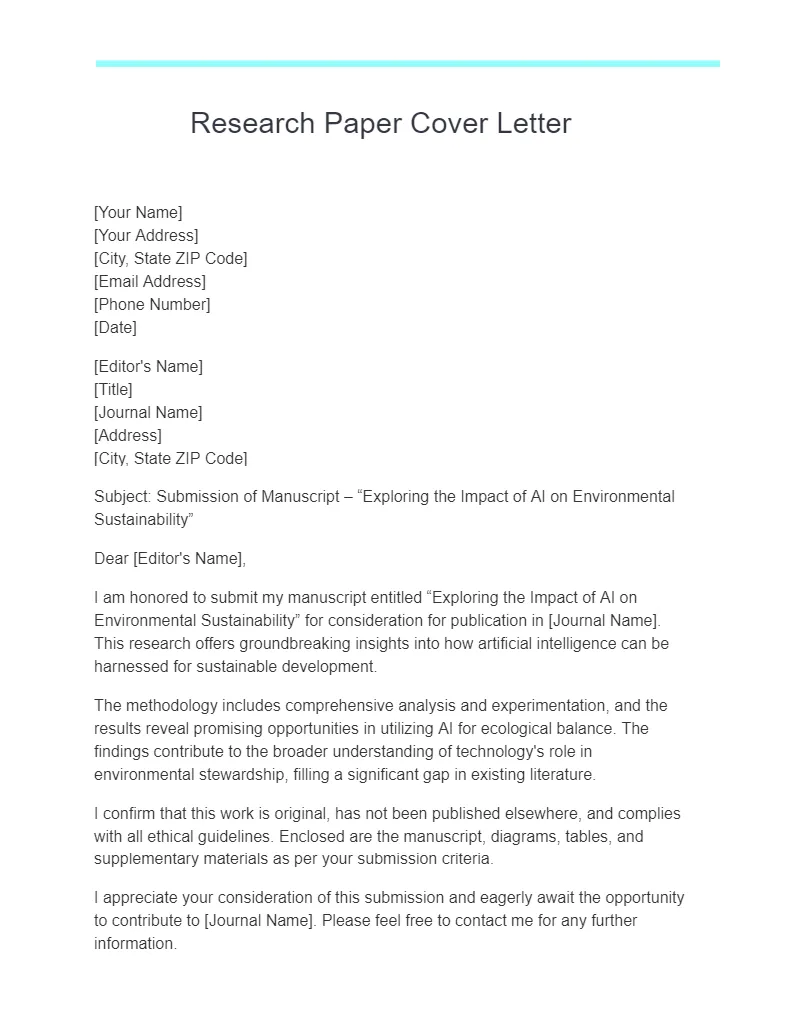What is a Research Paper Cover Letter
A research paper cover letter is a crucial document submitted alongside a research manuscript when you are aiming to publish your work in a scientific journal. It serves as an introduction to the editor and provides essential context about your research, its significance, and why it is suitable for the particular journal. This letter is not just a formality; it is a critical opportunity to make a positive first impression and increase the likelihood of your manuscript being accepted for review and, eventually, publication. A well-crafted cover letter can set your submission apart from others, emphasizing the importance and originality of your study.
Purpose of a Cover Letter
The primary purpose of a cover letter is to persuade the journal editor that your manuscript is worthy of consideration for publication. It provides the editor with a snapshot of your research, highlighting its key findings, methodology, and contribution to the field. The letter also gives you the chance to address any specific requirements or guidelines set by the journal. It also allows you to briefly explain why the journal is the best fit for your research, showcasing your understanding of the journal’s scope and audience. Furthermore, it is an opportunity to declare any conflicts of interest and confirm that all authors have approved the submission.
Importance in the Publication Process
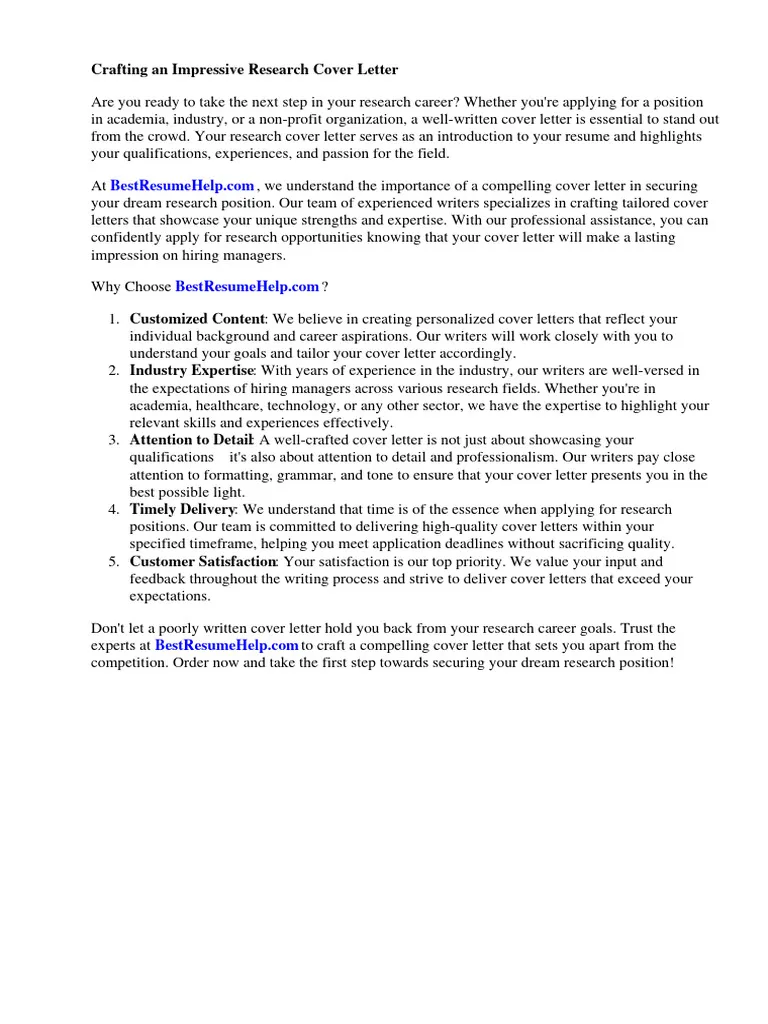
In the competitive world of academic publishing, a well-written cover letter significantly impacts the initial assessment of your manuscript. Editors often use cover letters to decide whether to send a paper out for peer review. A compelling cover letter can capture the editor’s attention and make them more inclined to take a closer look at your research. A strong cover letter demonstrates professionalism, attention to detail, and a genuine interest in publishing in that particular journal. Conversely, a poorly written or generic cover letter can lead to your manuscript being rejected outright, even if the research itself is sound. Therefore, investing time and effort into crafting a persuasive cover letter is essential for maximizing your chances of publication.
Key Components of a Cover Letter
A comprehensive cover letter should include several key components to effectively communicate the value of your research and meet the journal’s requirements. These components work together to provide a clear and concise overview of your manuscript and its relevance. Each element plays a vital role in convincing the editor that your work deserves consideration. Understanding these key elements is essential for creating a compelling cover letter.
Contact Information
Start by including your contact information, which typically includes your name, affiliation, email address, and possibly your phone number. This information ensures that the editor can easily reach you if they have any questions or need to communicate regarding your manuscript. It should be placed at the beginning of the letter, often aligned to the left or right. Make sure your email address is professional, and your contact information is up-to-date and accurate. This section establishes the formal tone of the letter.
Author Information
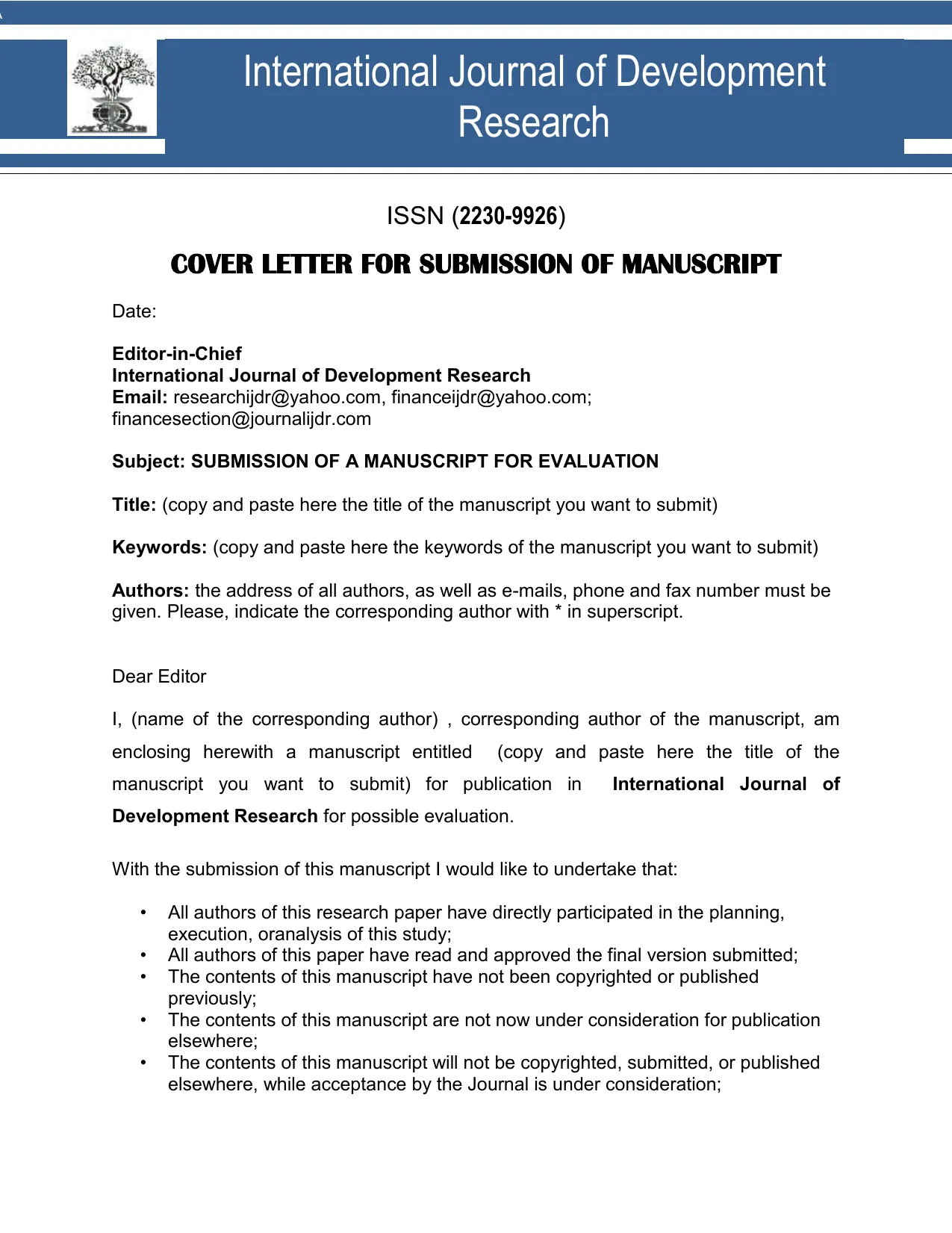
Include the names and affiliations of all authors, usually in the order they appear on the manuscript. Specify the corresponding author, who will be the primary point of contact for all communications related to the submission. This helps the editor to easily identify and contact the appropriate person for any inquiries. Mentioning all authors and their affiliations also gives credit to everyone involved in the research. Providing clear and accurate author information is critical for the editorial process.
Manuscript Details
Clearly state the title of your manuscript and the type of article you are submitting (e.g., original research, review article, case study). Also, indicate the journal to which you are submitting. Include any manuscript identification numbers if you are resubmitting after revisions. This section provides the editor with essential information to quickly identify your submission and understand the nature of your work. Accuracy in these details is crucial to avoid any confusion during the review process. This helps the editor organize and track the submission within the journal’s system.
Brief Summary of Research
Provide a concise summary of your research, highlighting the main objectives, methods, key findings, and conclusions. This section should be brief, typically around 100-150 words, and should effectively communicate the essence of your study. Focus on the most important aspects of your research, emphasizing its novelty and significance. Avoid technical jargon, and write in clear, accessible language that will appeal to a broad audience of the journal. This summary gives the editor a quick overview of your research before they delve into the full manuscript.
Statement of Significance
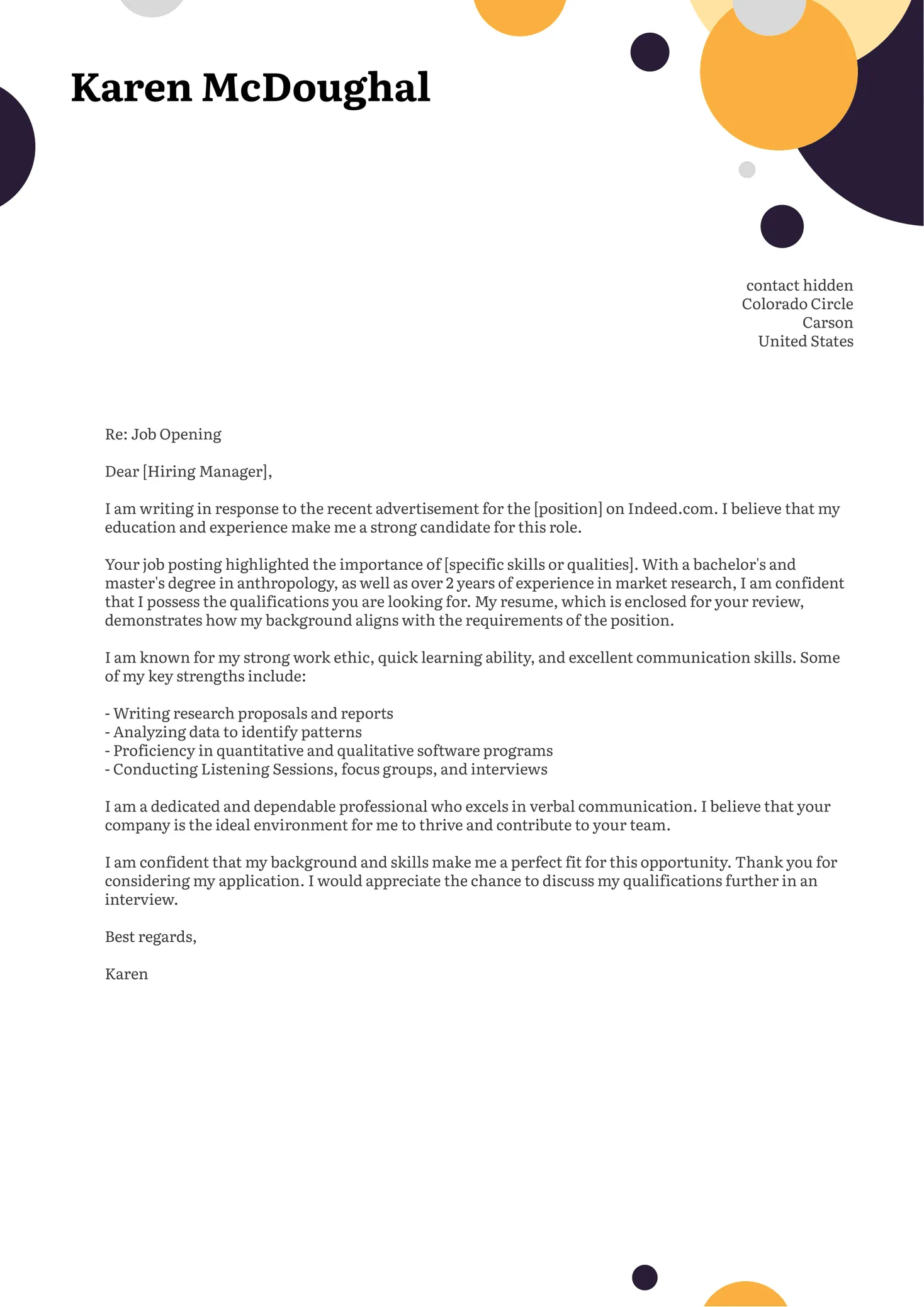
Clearly state the significance of your research and its contribution to the field. Explain why your findings are important and how they advance existing knowledge. This is where you make a strong case for the impact of your work, describing the potential implications of your research. Explain the practical applications, and target audience of your study. Convince the editor that your research is relevant and makes a valuable contribution to the existing body of knowledge. This is a critical section for setting your paper apart from others and emphasizing its importance to the scientific community.
Why This Journal
Explain why you have chosen to submit your manuscript to this particular journal. Mention how your research aligns with the journal’s scope, audience, and aims. Highlight any specific articles or issues of the journal that are relevant to your work. Demonstrate that you have researched the journal and understand its focus. Tailoring your cover letter to the specific journal demonstrates your seriousness and commitment to the publication. This shows the editor that you have carefully considered the journal’s requirements and that your work is a good fit for its readership. This attention to detail increases the chances of a positive initial assessment.
Disclosure of Conflicts of Interest
Disclose any potential conflicts of interest, such as financial or personal relationships that could influence your research or its interpretation. Transparency is crucial in academic publishing to maintain credibility and integrity. Declare all sources of funding for your research. If there are no conflicts of interest, explicitly state this. This demonstrates your commitment to ethical publishing practices and builds trust with the editor. Providing this information helps ensure the integrity of the publication process and helps the editor make informed decisions.
Following Guidelines
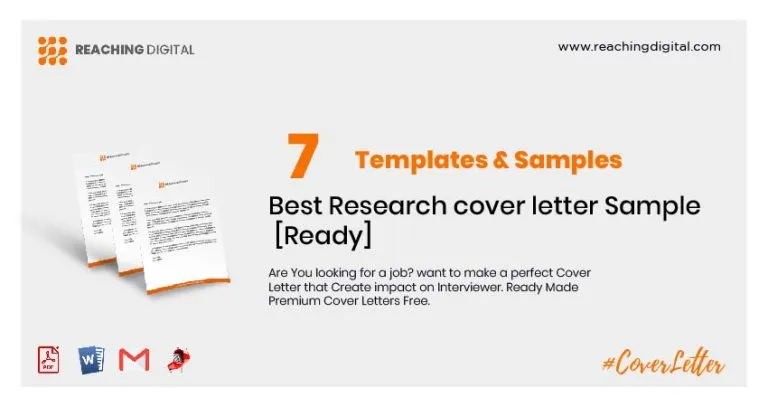
Adhering to the journal’s specific guidelines is essential for a successful submission. Each journal has its own set of requirements regarding formatting, word count, referencing style, and other aspects of the manuscript and cover letter. These guidelines are designed to ensure consistency and quality across all published articles. Failing to follow these guidelines can lead to rejection, regardless of the quality of your research. Therefore, always carefully review and adhere to the journal’s instructions.
Formatting and Structure
Pay close attention to the formatting requirements specified by the journal. Follow the recommended font, font size, and margin settings. Ensure that your cover letter is well-structured and easy to read, with clear paragraphs and appropriate spacing. Use the journal’s required letterhead if available. A clean and professional appearance is critical for making a positive first impression. Formatting should reflect professionalism and attention to detail, showcasing your commitment to meeting the journal’s standards. Following these guidelines improves the readability and overall quality of your submission.
Tone and Style
Maintain a professional and respectful tone throughout your cover letter. Address the editor appropriately, typically using their title and last name (e.g., Dear Dr. Smith). Be concise and to the point, avoiding overly verbose language. Convey your enthusiasm for your research and your interest in publishing in the journal. Be polite and avoid any demanding language. Your tone should be confident, but not arrogant. A well-mannered approach reflects professionalism and demonstrates your respect for the editorial process. The style should reflect your understanding of academic conventions.
Language and Grammar
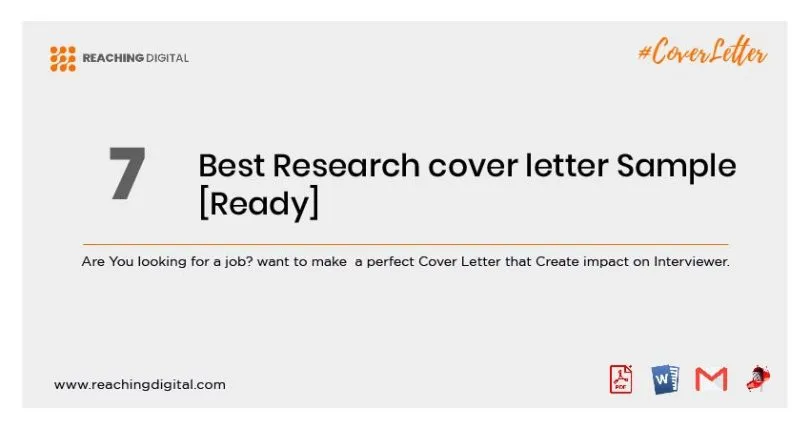
Ensure that your cover letter is free of grammatical errors, spelling mistakes, and typos. Proofread your letter carefully and consider having a colleague or professional editor review it. Clear and concise language is essential for conveying your message effectively. Use formal and precise language, appropriate for an academic context. The quality of your writing reflects the overall quality of your research. Ensure that the language is suitable for the target audience of the journal, and that the tone aligns with the expectations of academic publishing. This attention to detail can significantly enhance the impact of your letter.
Cover Letter Examples
Reviewing examples of cover letters can provide valuable insights into the structure, content, and tone of effective submissions. These examples offer guidance on how to communicate your research concisely and persuasively. By studying these models, you can gain a better understanding of what makes a cover letter successful and adapt these strategies to your specific manuscript and the target journal. These examples can serve as a practical guide to writing your own cover letter.
Example 1 Research in Specific Field
This example focuses on a cover letter for a research paper in a specialized field, such as molecular biology or astrophysics. The letter would highlight the research’s unique contribution to this specific area, explaining how the findings advance the existing knowledge base. The writer should tailor the language and terminology to align with the journal’s specialized audience. The introduction should concisely state the purpose of the research, main methods used, and key results. The significance section would stress the practical implications within the discipline, which will enhance the chance of acceptance.
Example 2 Methodological Study
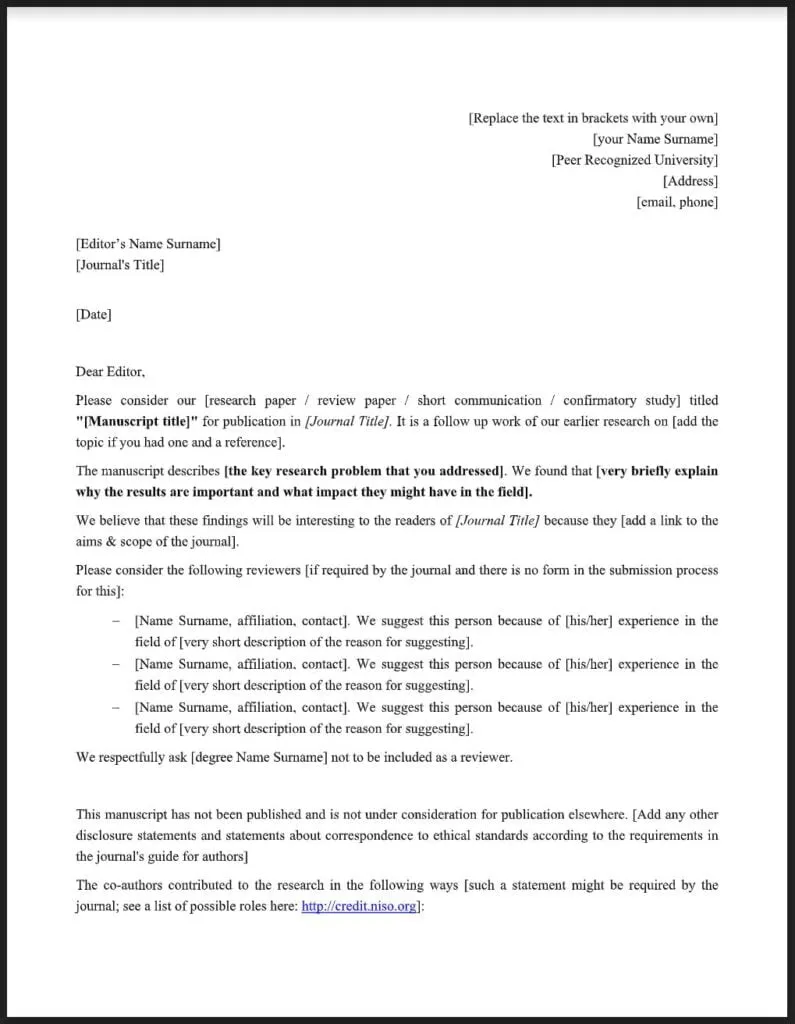
This example targets a cover letter for a methodological study. The letter should highlight the innovativeness of the methods used, how they improve upon existing techniques, or what new insights they bring. A strong emphasis should be placed on the reliability and validity of the approach and its broader applicability. The introduction would concisely summarize the methods developed and their purpose. The significance section might highlight the potential of these methods to influence other fields. The cover letter should demonstrate a thorough understanding of methodological rigor and its impact on research outcomes. This approach is vital for studies aiming to refine research methodology.
Example 3 Literature Review
This example is for a cover letter accompanying a literature review. The letter must clarify how the review is comprehensive and current, and discuss any new synthesis or insights that it provides. The introduction should establish the research topic and overview of the literature. The significance section should show the relevance and influence of the research. If it is a systematic review, then the methodology should be detailed. It is essential to show the depth of research done, critical analysis of the literature, and provide clear and valuable insights to other researchers in the field. This is a critical aspect of academic writing.
Best Practices and Tips
Following best practices ensures that your cover letter effectively communicates your research and meets the standards of academic publishing. These tips enhance your chances of a successful submission. Incorporating these suggestions will help you present your work in the best possible light, leading to a more favorable evaluation by the journal editor. Each suggestion contributes to the overall quality and impact of your submission.
Tailoring to the Journal
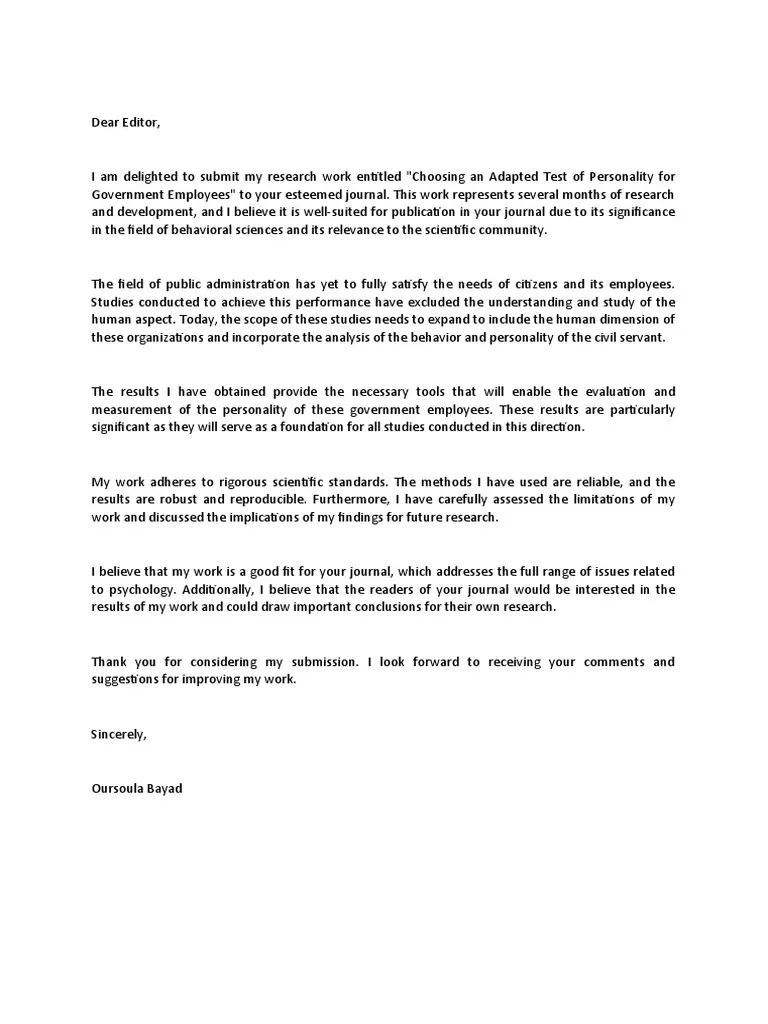
Always tailor your cover letter to the specific journal you are submitting to. Research the journal’s scope, readership, and aims to understand its focus. Customize your letter to emphasize the aspects of your research that align with the journal’s interests. Refer to specific articles or issues that relate to your work, demonstrating that you have carefully considered the journal’s focus. This personalization shows the editor that you understand the journal and increases your chances of a favorable review. Personalization proves your diligence and commitment to the publication process.
Proofreading and Editing
Thoroughly proofread and edit your cover letter before submitting it. Check for grammatical errors, spelling mistakes, and typos. Consider having a colleague or professional editor review your letter for clarity and style. Ensure that the language is clear, concise, and appropriate for an academic audience. The quality of your writing reflects the quality of your research, so ensure that your cover letter presents your work in the best possible light. This attention to detail is essential for making a positive first impression.
Seeking Feedback
Seek feedback from colleagues, mentors, or professional editors before submitting your cover letter. Ask them to review your letter for clarity, accuracy, and effectiveness. Their feedback can provide valuable insights and help you identify areas for improvement. Get feedback from experienced researchers or publication experts to ensure that your letter meets the standards of academic publishing. Consider their suggestions and revise your letter accordingly. External input enhances the quality and impact of your cover letter.
Common Mistakes to Avoid
Avoiding common mistakes is essential for ensuring that your cover letter makes a positive impression and increases your chances of publication. Being aware of these pitfalls will help you to craft a strong, professional letter. Correcting these issues will enhance the overall quality of your submission. By avoiding these errors, you can demonstrate your professionalism and increase the likelihood that your manuscript will be accepted for review.
Overly Casual Tone
Avoid using an overly casual or informal tone in your cover letter. Maintain a professional and respectful approach throughout. Use formal language and address the editor appropriately. A casual tone can undermine your credibility and make a negative impression. Your cover letter should reflect the same level of professionalism as your research. An overly relaxed tone diminishes the impact of your submission and may reflect negatively on your overall approach to academic writing.
Generic Content
Do not use generic or template-based content. Tailor your letter to the specific journal and your research. Avoid using generic phrases that could apply to any manuscript. Personalize your letter to reflect the unique aspects of your research and its relevance to the journal. A generic letter shows a lack of attention to detail and may indicate that you haven’t researched the journal thoroughly. Customization improves the impact and relevance of your submission and highlights the specific contribution of your study.
Ignoring Instructions
Always follow the journal’s specific instructions for cover letter format and content. Ignoring these guidelines can lead to rejection. Review the journal’s author instructions carefully and adhere to their requirements. Pay attention to formatting, word count, and any other specific requests. Failing to follow instructions indicates a lack of attention to detail and may lead to your manuscript being rejected. Conforming to all of the journal’s requirements is essential for a successful submission.
Conclusion
Writing an effective research paper cover letter is a critical skill for academic researchers. By understanding the purpose, key components, and best practices, you can significantly increase your chances of having your manuscript accepted for publication. Remember to tailor your letter to the specific journal, proofread carefully, and seek feedback from others. Avoiding common mistakes such as a casual tone, generic content, and ignoring instructions will also strengthen your submission. By following these guidelines, you can create a compelling cover letter that showcases your research and makes a positive impression on the journal editor, paving the way for your work to be published and recognized in your field.
